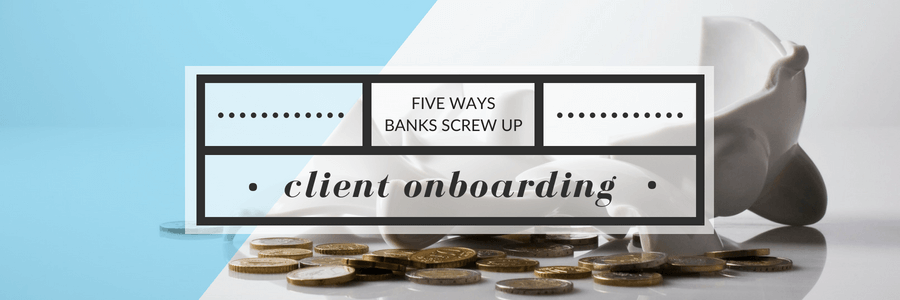First impressions count.
That’s why the client onboarding process that banks provide has to be good. If a client has a bad experience with your bank while they’re trying to become a customer, what does that tell them about the rest of the experiences they’ll have?
In a competitive market, banks have a lot to lose if their first impression isn’t an impressive one.
%
Average attrition rate for top 100 banks in U.S. [1]
Max amount ($) that financial institutions invest in onboarding a single client. [3]
Number of U.S. banks customers can choose from depending on needs. [2]
1 ) You’re treating the process as a series of transactions, rather than a complete process.
I see a lot of banks think of onboarding as front-office operations and back-office operations – two totally separate processes. This mentality silos departments resulting in them using different product systems and technologies. It prohibits them from sharing customer data and having an integrated central view of the client’s activities. And it also causes disjointed communication across departments, more errors and a longer onboarding time.
According to an Accenture Strategy study…[1]
Number of steps in average onboarding process. [1]
%
Banking clients that abandon onboarding before completion. [1]
2) You ask your clients for paper signatures.
The signing ceremony is a major bottleneck in the onboarding process. It can take up to five days longer than acquiring an electronic signature.
%
SunTrust Bank cut agreement closing from four days to two with e-signature. They also noticed a reduction in email complaints and improved customer satisfaction. [5]
According to Celent, BMO saves approximately $98.2M per year by converting from paper to eForms. [5]
%
Customers of a Top 5 U.S. Bank that choose e-signature over paper. [5]
3) Your clients cannot participate in onboarding on their mobile device.
You probably knew this was going to be a reason your process is failing…mobile is everything so if you can’t beat ‘em, join ‘em.
%
Consumers using their bank’s mobile banking app.[4]
Capital One, Bank of America & TD Bank
Top three highest ranked U.S. mobile banking applications based on satisfaction.[4]
%
Users less likely to switch providers because they’re satisfied with the mobile banking experience.[4]
Availability of Key Information
One of the major components of mobile banking app satisfaction.[4]
4) Your clients feel neglected/you don’t interact with them.
Nothing is more frustrating than not knowing when you can start to use your products. This frustration builds when you call to ask and get unhelpful or wrong answers.
%
Average amount of technology budget used to support aging systems. [4]
Manual onboarding can cost up to 20 times more than automated systems. [4]
Communication is key in onboarding and that starts with having visibility into processes. To answer client questions, see how quickly work is completed, etc. your banking software should include comprehensive dashboards. Dashboards can reveal information such as the estimate to complete date, what’s next in the process, and more.
5) Clients don’t have a comprehensive view of their accounts.
Systems housed on-premise create silos between departments and branches. When this happens, clients cannot immediately see the results of their transactions and they definitely can’t be serviced at any branch.
To make client information more accessible, your ERP systems need to be deployed in the cloud. “A single, integrated, cloud-based system allows financial institutions to build a window into their operational, process and customer information – getting a real-time 360-degree view of customer activity, and eliminating the complexity of the multistep process for customers to gain a comprehensive view of their accounts.” [6] There are a lot of other reasons to consider deploying a solution in the cloud too – such as the fact that it’s easy, it removes administrative tasks that handicap onboarding, and it frees you to focus on business development initiatives. Click to learn about the different options for deploying a solution in the cloud.
If you think your client onboarding process might be a fail at least in one of the above categories, check out this interactive webpage. It goes into further detail about how, why and where your banking onboarding process is failing.

Anna Morris
Account Executive
[1] Accenture Strategy. (2017, September 15). Black Hole to White Glove: Transform Investment Bank Onboarding to Improve Client Experiences and Grow Revenue. Retrieved from SlideShare: https://www.slideshare.net/accenture/black-hole-to-white-glove-transform-investment-bank-onboarding-to-improve-client-experiences-and-grow-revenue
[2] Federal Deposit Insurance Corporation. (2018). FDIC Quarterly | Quarterly Banking Profile: First Quarter 2018. Arlington: Division of Insurance and Research of the FDIC. Retrieved from FDIC.
[3] Marous, J. (2017, July 5). 7 Steps to Improve Customer Onboarding. Retrieved from The Financial Brand: https://thefinancialbrand.com/66143/7-steps-to-improved-customer-onboarding/
[4] Marous, J. (2017, June 21). Not All Mobile Banking Apps Are Created Equal. Retrieved from The Financial Brand: https://thefinancialbrand.com/66006/mobile-retail-banking-application-satisfaction-study/
[5] OneSpan. (2018). Best Practices for Deploying E-Signatures to the Bank Branch. OneSpan North America, Inc. Retrieved from OneSpan: https://www.esignlive.com/sites/esign/files/2018-05/OneSpan_ESignaturestothebankbranch_052618_web.pdf
[6] Rieker, F. (2016, April 28). Why You Should Be Banking in the Cloud. Retrieved from Forbes: https://www.forbes.com/sites/sap/2016/04/28/why-you-should-be-banking-in-the-cloud/#78d2d0e459b9

